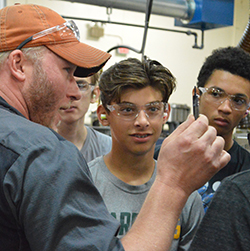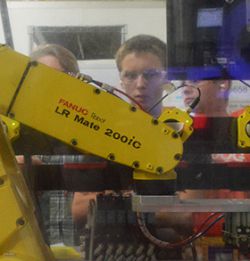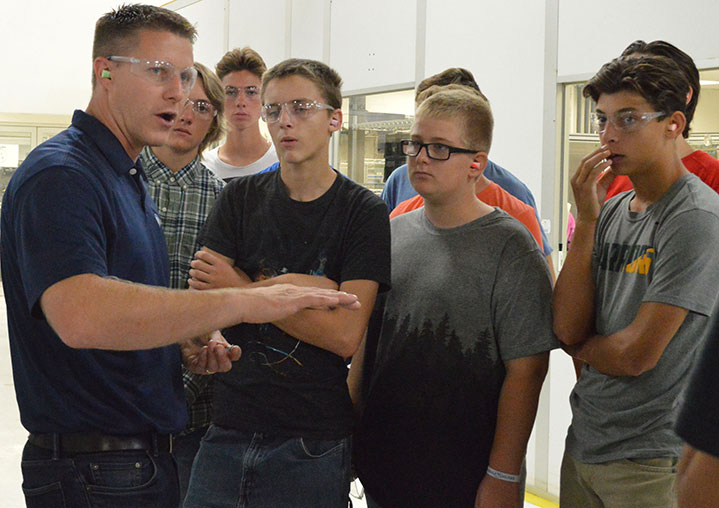Let’s talk about a glaring example of the disconnect between the workforce and the pipeline of students who will soon enter it.
Last spring, Kent ISD, in partnership with local school districts, area manufacturing representatives, and Grand Rapids Community College, started advertising Launch U. That’s an early middle-college program that puts students directly into training for jobs in manufacturing with local businesses, allowing them to earn a free associate degree and credentials in the field.
Bridging the Talent Gap: To maintain a thriving economy, students need to be prepared for high-demand, well-paying jobs, yet there are currently more jobs than skilled workers to fill them. This series will look at how schools are preparing students for the future workforce.
Jobs Growing Here
Source: Talent 2025, West Michigan Talent Assessment and Outlook, published in August. |
One snafu in planning was that partner companies didn’t want to promise to hold off hiring until students completed the program. Take a moment to consider that: The company representatives wanted to be able to hire the students, potentially before they completed the program.
Now consider this: Not enough students enrolled in two of the Launch U programs, precision machining and industrial maintenance, for those programs to start as scheduled in late August.
“We couldn’t get 24 students to sign up,” said Bill Smith, assistant superintendent of instructional services for Kent ISD. The plan is to reintroduce the programs next fall.
Smith said he believes many students aren’t getting the message that there are quicker and more affordable routes than a four-year degree into industries where they can thrive andmake high wages. “The system that markets to the kids is still leaning toward ‘every kid of value should go to a four-year institution,'” Smith said.
“Until we change that mindset we are going to have these types of jobs sitting open. This is free education, a free associate’s, free workplace-recognized credentials in fields where you are going to get a job and that job is going to pay $80 K.”
Jobs are Unfilled
Smith was recently part of a group that met with Gov. Rick Snyder and U.S. Secretary of Labor Alexander Acosta to talk about the gap between skilled workers and in-demand jobs, known as the “talent gap.” According to Snyder, 120,000 available jobs in Michigan are unfilled. Many are in the areas of manufacturing, engineering, information technology and hybrids of these fields.
“There is a need to have stackable credentials, and that need is greater than a college degree,” Smith said. “These jobs don’t go unfilled because people are unavailable; it’s because the talent isn’t aligned to get the job. We have to import workers when we really shouldn’t have to.”
Some companies have long vacancy lists of jobs, he added: “It’s almost impossible to fathom that we have that many jobs open and we can’t connect the unemployed to those jobs.”
With careers rapidly changing and college costs skyrocketing, it’s time for students to become exposed to the fact that there are post-secondary education and training options besides a four-year degree, he said.
‘The scarcity of talent to fill open jobs is being seen across every industry and at every occupation level.’ — Kevin Stotts, Talent 2025
Still, about 70 percent of all jobs require some kind of post-secondary education: technical certification, an apprenticeship, an associate or four-year degree.
“Kids have to be graduating from high school and they have to be going on to get some kind of post-secondary training, but it’s a wide range,” said Kevin Stotts, president of Talent 2025. Representing 115 area CEOs in manufacturing, healthcare, information technology, construction, engineering and business services, Talent 2025 works to align talent with workplace needs. (Talent 2025 is a Sustaining Sponsor of SNN)
But ingraining that message into K-12 schools requires a shift, Stotts said.
“There was such an emphasis on ‘go to college.’ That was your ticket. (But) that could mean getting a degree in a field where there was no demand for that education and training.”
The “college” message was very strong during the economic downturn a few years ago and, though job losses occurred across many industries, manufacturing got a really bad rap, he said. Young people stopped considering it as an option, but the industry has since rebounded and revolutionized.
“We have more than recovered the jobs lost in the manufacturing industry since the Great Recession,” Stotts said. “The jobs that are back are better paying, require technical knowledge and skill, they are utilizing technology and they are in cleaner environments.”

Shrinking the Gap
With the gap becoming more evident, schools and businesses are working together to prepare students for the future West Michigan workforce.
Sixty Byron Center High School students recently toured four area manufacturers to get an up-close, hands-on look at operations that put them in touch with employers in the region’s biggest industry.
Junior Harrison Kosak said he wants to work in engineering or robotics, and that it helps to see what’s out there while still in high school.
“It helps me get more in-depth with what I want to do,” Harrison said as he toured Autocam Precision Components. “I can look at these different occupations and see what I might be interested in.” Students also visited Lacks Enterprises, Ranir LLC and Swoboda.
Byron Center High School teacher Lary Shoemaker, who teaches drafting, CAM/CNC classes and pre-engineering, has 140 students taking his classes — more than 10 percent of the high school’s enrollment — proving that gearing up students for high-demand jobs is possible.
“In West Michigan, the school districts recognize that 25 percent of our jobs are in the manufacturing sector,” Shoemaker said. “We have companies right in Byron Center that are direct placement for students that enter this career path. We have great companies in Grand Rapids that support a manufacturing environment at the high school level.”
Autocam Precision Components is one example. Steve Heethuis, training director for the Kentwood firm, talked to the visiting students about career-pathway opportunities right at the company: apprenticeships and the Advanced Manufacturing Partnership, which gives employees the opportunity to receive an associate degree for free. Many go on to get engineering degrees. The company also offers internships, scholarships and is a partner in the Launch U Program.
“We are interested in them getting curious about manufacturing,” Heethuis said. “If they have an opportunity to come work for us or any other manufacturer, we feel like it’s a success because we recognize that manufacturing is absolutely vital to our long-term economic regional success. We feel like it’s our leadership position to introduce students to manufacturing.”
‘The system that markets to the kids is still leaning toward “every kid of value should go to a four-year institution.”‘ — Bill Smith, Kent ISD
Two years ago, Byron Center hosted a college and career day, which included several area manufacturers who presented educational opportunities and apprentice programs.
“Anytime you can have students really talk directly to the people that are potential employers, it’s good real world experience,” Shoemaker said. “It’s almost like a pre-interview.”
Shoemaker, who worked 22 years in manufacturing before starting his teaching career, said schools need to play a role in shifting the paradigm when it comes to how skilled-trades jobs are viewed. It’s possible to receive training and degrees, paid for by companies and allowing students to finish without debt and with direct access to jobs. He’d also like more teachers to come from manufacturing backgrounds.

A Tight Market, Rising Wages
With regional unemployment below 4 percent, the job market is tight, Stotts said.
“That’s a marked change from seven years ago,” he stressed. “The unemployment rate is significantly less than even just a year ago. Employers are trying to find any available talent, so the scarcity of talent to fill open jobs is being seen across every industry and at every occupation level. … It’s tight across the board, across all industries.”
As a result, wages are projected to rise by more than 20 percent in several industries over the next 10 years.
Employers are coming together with education and workforce partners to consider education and training requirements, and how they line up with talent-development programs, Stotts said.
Working together, businesses and schools can begin exposing students to careers as early as middle school.
“The more we can expose students to the variety of industries and jobs and career pathways,” Stotts said, “the more informed those kids and their families will be about what it’s like to work in a field like manufacturing, and where they can go to get education and training.”
As he toured the manufacturing area of Autocam Precision Components, Byron Center High School junior Devin Merchant said he’s glad to have the opportunity to get out in the field.
“I’m interested in computer hardware engineering,” Devin said. “I think exposing myself to as many opportunities as possible will be beneficial to me in the future.
“There are so many opportunities out there that I didn’t even realize there were.”
CONNECT











